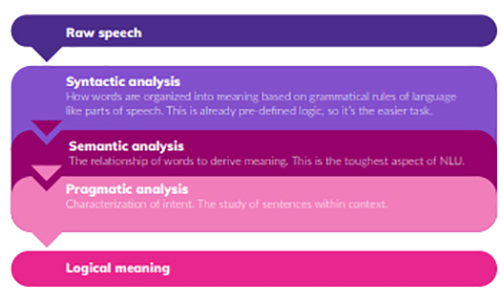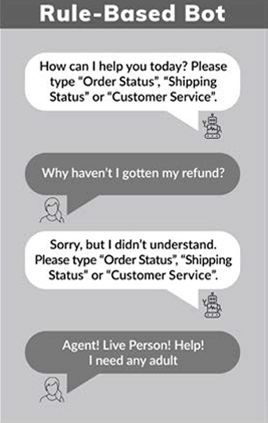Artificial intelligence is transforming business models and the way many of us live our lives. Businesses use AI for everything from identifying fraudulent insurance claims to improving customer service to predicting the best schedule for preventive maintenance of factory machines. And if you use a Nest thermostat, unlock your phone with facial recognition, or have ever said, "Alexa, turn off the lights," you're using artificial intelligence in your everyday life.
As ubiquitous as artificial intelligence is becoming, too many people it's still a mystical concept capable of magic. While some of its capabilities do seem magical, artificial intelligence consists of very real and tangible technologies such as natural language processing (NLP), natural language understanding (NLU), and machine learning (ML). If these terms sound like "hocus pocus” to you, you're reading the right article. Together, we'll explore the definitions of NLP and NLU and look at examples of how contact centers are using them to enhance CX and increase efficiency.
A brief overview of contact center AI
Artificial intelligence is showing up in call centers in surprising and creative ways. Cloud contact center vendors have been busy infusing AI into core applications as well as creating brand new solutions that effectively leverage the huge amount of data that call centers produce. If it seems like AI is everywhere in call centers these days, you're right. Here are some AI-powered capabilities that are improving call center results.
- Recommending forecasting algorithms. Workforce management software that's infused with artificial intelligence can analyze vast quantities of historical volume data and recommend the best forecasting algorithm to use, resulting in more accurate forecasts.
- Routing interactions based on customer personality and preferences. When automatic contact distributors (ACDs) use artificial intelligence, organizations are able to personalize interactions by matching customers to agents with whom they're likely to make a personal connection.
- Enabling more natural self-service experiences. Self-service tools that use AI - like conversational IVRs and virtual agents - allow users to solve their problems using their own words.
- Real-time agent coaching. Real-time interaction guidance solutions can analyze customer sentiment and agent behaviors and provide agents with real-time tips for improving interactions as they're happening.
This is by no means a comprehensive list, but you can see how artificial intelligence is transforming processes throughout the contact center. And most of these new capabilities wouldn't be possible without natural language processing and natural language understanding.
What are NLP and NLU?
Natural language processing is a technological process that powers the capability to turn text or audio speech into encoded, structured information. Machines that use NLP can understand human speech and respond back appropriately. This allows humans to interact with computers using conversational speech.
NLU is a subcategory of NLP that enables machines to understand the incoming audio or text. Its counterpart is natural language generation (NLG), which allows the computer to "talk back." When the two team up, conversations with humans are possible.
NLU turns unstructured text and speech into structured data to help understand intent and context. As you can imagine, this is no easy task. Human speech is complicated because it doesn't always have consistent rules and variations like sarcasm, slang, accents, and dialects can make it difficult for machines to understand what people really mean.
NLU uses several methods to navigate these complexities. Syntactic analysis applies rules about sentence structure (syntax) to derive part of the meaning of what's being said. Semantic analysis determines the relationship of words to derive meaning. And pragmatic analysis looks at the context of sentences to identify intent. The combination of these analysis techniques turns raw speech into logical meaning.

You've used natural language processing if you've ever done any of the following:
- Used voice to text when sending a text message
- Shouted "representative" when interacting with an IVR
- Asked Siri for a weather forecast
- Used autocomplete or grammar checkers when typing
- Used online translation tools on a foreign language website
These capabilities make it easy to see why some people think NLP and NLU are magical, but they have something else in their bag of tricks - they use machine learning to get smarter over time. Machine learning is a form of AI that enables computers and applications to learn from the additional data they consume rather than relying on programmed rules. Systems that use machine learning have the ability to learn automatically and improve from experience by predicting outcomes without being explicitly programmed to do so.
Now that we've established that:
- NLP allows humans and computers to communicate conversationally
- NLU is the subprocess of NLP that understands human speech, including context and intent
- Both NLP and NLU improve with use due to machine learning
let's take a closer look at two contact center solutions that leverage NLP and NLU - conversational IVRs and chatbots.
Conversational IVRs
Traditional interactive voice response (IVR) systems greet customers at the beginning of inbound calls, allow callers to interact with menus, and facilitate self-service. Most people know IVRs as the system that makes them "Press 1 for sales" and often makes it really hard to talk to an agent.
Thankfully, NLP can be used to greatly improve the IVR user experience. The first iteration of using NLP with IVRs eliminated the need for callers to use their phone's keypad to interact with IVR menus. Instead of "pressing 1 for sales," callers could just say "1" or "sales." This is more convenient, but it's very rule-based and still leaves customers to contend with often overly complex menu trees.
The introduction of conversational IVRs completely changed the user experience. When customers are greeted with, "How can we help you today?", they can simply state their issue and NLP/NLU will understand them and enable them to bypass menus all together. This translated input then tells the IVR what to do next. For example, if the caller says, "I need to activate my new debit card," the IVR would know to route the caller to a qualified agent, or perhaps route the customer to self-service where NLP would once again allow them to interact with the system conversationally.
Conversational IVRs create a more natural customer service experience. Instead of worrying about keeping track of menu options and fiddling with keypads, callers can just say what they need help with and complete more effective and satisfying self-service transactions. Additionally, conversational IVRs enable faster and smarter routing, which can lead to speedy and more accurate resolutions, lower handle times, and fewer transfers. It may take a while, but NLP is bound to improve consumers' perceptions of IVRs.
Chatbots
Chatbots are everywhere these days and you may have noticed that the chatbots you've encountered fall on a broad spectrum of capabilities. On the simple end of the spectrum are chatbots that don't use any artificial intelligence, instead of relying on defined rules to guide their actions. These chatbots aren't capable of handling anything that falls outside of what they're programmed to do, which can sometimes result in unfortunate interactions like the one below:

While these chatbots can be useful for handling narrowly defined tasks, like answering common questions, they can't understand human speech beyond the terms they've been programmed to recognize, and they will never improve without human intervention.
On the other end of the spectrum are sophisticated chatbots, also known as virtual agents, that use NLP, NLU, and machine learning to provide conversational customer support that improves over time. These bots aren't limited by programmed rules and keywords; NLP enables them to understand what users are saying to them and respond accurately or perform the right action. Picture Apple's Siri or Amazon's Alexa as a support chatbot to get a feel for the speech capabilities of bots that use NLP and machine learning.
Chatbots that leverage artificial intelligence provide a better, more effective customer experience than rule-based bots. Because they can understand human speech and user intent, they're capable of executing a much broader set of tasks, including facilitating complete, end-to-end self-service. And if self-service isn't in the cards, these chatbots can gather information and pass it to an agent, which reduces handle times and labor costs.
Learn more about contact center AI
Hopefully, this article has given you a better understanding of NLP and NLU and how they can be applied in the contact center to improve self-service experiences and increase efficiency. To learn more about contact center AI in a fun, relatable way, download Contact Center AI Explained by Pop Culture. You'll be speaking the magical language of AI in no time!




